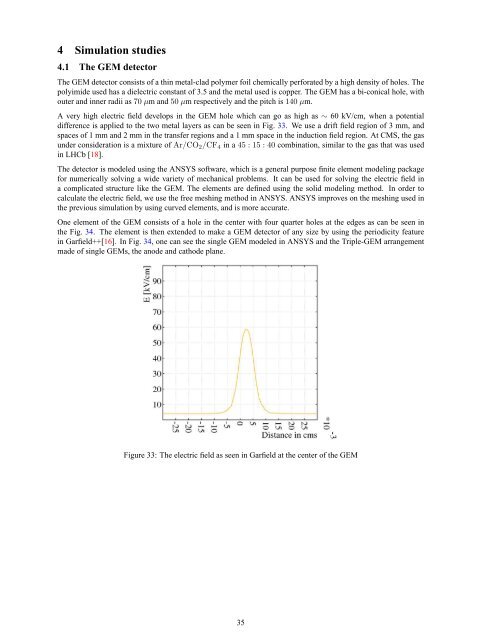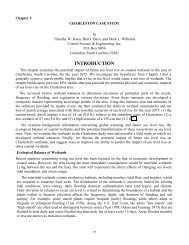A GEM Detector System for an Upgrade of the CMS Muon Endcaps
A GEM Detector System for an Upgrade of the CMS Muon Endcaps
A GEM Detector System for an Upgrade of the CMS Muon Endcaps
Create successful ePaper yourself
Turn your PDF publications into a flip-book with our unique Google optimized e-Paper software.
4 Simulation studies<br />
4.1 The <strong>GEM</strong> detector<br />
The <strong>GEM</strong> detector consists <strong>of</strong> a thin metal-clad polymer foil chemically per<strong>for</strong>ated by a high density <strong>of</strong> holes. The<br />
polyimide used has a dielectric const<strong>an</strong>t <strong>of</strong> 3.5 <strong>an</strong>d <strong>the</strong> metal used is copper. The <strong>GEM</strong> has a bi-conical hole, with<br />
outer <strong>an</strong>d inner radii as 70 µm <strong>an</strong>d 50µm respectively <strong>an</strong>d <strong>the</strong> pitch is140 µm.<br />
A very high electric field develops in <strong>the</strong> <strong>GEM</strong> hole which c<strong>an</strong> go as high as ∼ 60 kV/cm, when a potential<br />
difference is applied to <strong>the</strong> two metal layers as c<strong>an</strong> be seen in Fig. 33. We use a drift field region <strong>of</strong> 3 mm, <strong>an</strong>d<br />
spaces <strong>of</strong> 1 mm <strong>an</strong>d 2 mm in <strong>the</strong> tr<strong>an</strong>sfer regions <strong>an</strong>d a 1 mm space in <strong>the</strong> induction field region. At <strong>CMS</strong>, <strong>the</strong> gas<br />
under consideration is a mixture <strong>of</strong> Ar/CO2/CF4 in a 45 : 15 : 40 combination, similar to <strong>the</strong> gas that was used<br />
in LHCb [18].<br />
The detector is modeled using <strong>the</strong> ANSYS s<strong>of</strong>tware, which is a general purpose finite element modeling package<br />
<strong>for</strong> numerically solving a wide variety <strong>of</strong> mech<strong>an</strong>ical problems. It c<strong>an</strong> be used <strong>for</strong> solving <strong>the</strong> electric field in<br />
a complicated structure like <strong>the</strong> <strong>GEM</strong>. The elements are defined using <strong>the</strong> solid modeling method. In order to<br />
calculate <strong>the</strong> electric field, we use <strong>the</strong> free meshing method in ANSYS. ANSYS improves on <strong>the</strong> meshing used in<br />
<strong>the</strong> previous simulation by using curved elements, <strong>an</strong>d is more accurate.<br />
One element <strong>of</strong> <strong>the</strong> <strong>GEM</strong> consists <strong>of</strong> a hole in <strong>the</strong> center with four quarter holes at <strong>the</strong> edges as c<strong>an</strong> be seen in<br />
<strong>the</strong> Fig. 34. The element is <strong>the</strong>n extended to make a <strong>GEM</strong> detector <strong>of</strong> <strong>an</strong>y size by using <strong>the</strong> periodicity feature<br />
in Garfield++[16]. In Fig. 34, one c<strong>an</strong> see <strong>the</strong> single <strong>GEM</strong> modeled in ANSYS <strong>an</strong>d <strong>the</strong> Triple-<strong>GEM</strong> arr<strong>an</strong>gement<br />
made <strong>of</strong> single <strong>GEM</strong>s, <strong>the</strong> <strong>an</strong>ode <strong>an</strong>d cathode pl<strong>an</strong>e.<br />
Figure 33: The electric field as seen in Garfield at <strong>the</strong> center <strong>of</strong> <strong>the</strong> <strong>GEM</strong><br />
35
















